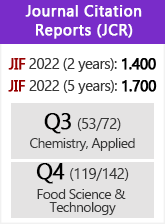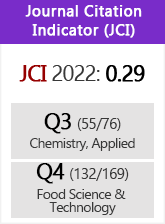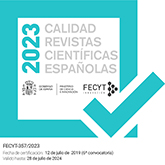Structure and thermal properties of beeswax-based oleogels with different types of vegetable oil
DOI:
https://doi.org/10.3989/gya.0806192Keywords:
Beeswax, Critical concentration, Microstructure, Oxidative ability, TextureAbstract
Beeswax-based oleogels with different types of vegetable oil, including camellia oil (CO), soybean oil (SO), sunflower oil (SFO), or flaxseed oil (FO), were prepared and their structure and thermal properties were evaluated. The critical concentration of oleogel obtained from each of CO, SO, and SFO at 25 °C was 3% (w/w), and that from FO was 4%. Thermal measurements revealed similar thermodynamic curves for oleogels in different lipid phases. X-Ray diffraction showed orthorhombic perpendicular subcell packing and characteristic peaks of the β’ form. Furthermore, a morphology analysis of the crystals showed that they were needle shaped. Fourier transform-infrared spectra revealed that beeswax-based oleogels were formed via non-covalent bonds and may be stabilized with physical entanglements. The oleogels showed oil type-dependent oxidative abilities, but they were all stable and showed no obvious changes in peroxide value during 90 days of storage at 5 °C.
Downloads
References
AOCS. 1987. Peroxide value acetic acid - chloroform method (Cd 8-53). American Oil Chemists' Society. AOCS Press, Champaign, US
Abdallah DJ, Weiss RG. 2000. n-Alkanes gel n-alkanes (and many other organic liquids). Langmuir 16, 352-355. https://doi.org/10.1021/la990795r
Adel R den, Heussen PCM, Bot A. 2010. Effect of water on self-assembled tubules in α-sitosterol +β-oryzanol-based organogels. J. Physics: Conference Series 247, 012025. https://doi.org/10.1088/1742-6596/247/1/012025
Asperger A, Engewald W, Fabian G. 1999. Analytical characterization of natural waxes employing pyrolysis-gas chromatography-mass spectrometry. J. Anal. Appl. Pyrolysis 50, 103-115. https://doi.org/10.1016/S0165-2370(99)00031-5
Dassanayake LSK, Kodali DR, Ueno S, Sato K. 2012. Crystallization kinetics of organogels prepared by rice bran wax and vegetable oils. J. Oleo Sci. 61, 1-9. https://doi.org/10.5650/jos.61.1 PMid:22188800
Dassanayake LSK, Kodali DR, Ueno S, Sato K. 2009. Physical Properties of Rice Bran Wax in Bulk and Organogels. J. Am. Oil Chem. Soc. 86, 1163-1173. https://doi.org/10.1007/s11746-009-1464-6
Doan CD, To CM, De Vrieze M, Lynen F, Danthine S, Brown A, Dewettinck K, Patel AR. 2017. Chemical profiling of the major components in natural waxes to elucidate their role in liquid oil structuring. Food Chem. 214, 717-725. https://doi.org/10.1016/j.foodchem.2016.07.123 PMid:27507530
Doan CD, Van de Walle D, Dewettinck K, Patel AR. 2015. Evaluating the Oil-Gelling Properties of Natural Waxes in Rice Bran Oil: Rheological, Thermal, and Microstructural Study. J. Am. Oil Chem. Soc. 92, 801-811. https://doi.org/10.1007/s11746-015-2645-0
Fayaz G, Goli SAH, Kadivar M. 2017. A Novel Propolis Wax- Based Organogel: Effect of Oil Type on Its Formation, Crystal Structure and Thermal Properties. J. Am. Oil Chem. Soc. 94, 47-55. https://doi.org/10.1007/s11746-016-2915-5
Hughes NE, Marangoni AG, Wright AJ, Rogers MA, Rush JW. 2009. Potential food applications of edible oil organogels. Trends Food Sci. Technol. 20, 470-480. https://doi.org/10.1016/j.tifs.2009.06.002
Hwang HS, Kim S, Singh M, Winkler-Moser JK, Liu SX. 2012. Organogel formation of soybean oil with waxes. J. Am. Oil Chem. Soc. 89, 639-647. https://doi.org/10.1007/s11746-011-1953-2
Hwang HS, Singh M, Bakota EL, Winkler-Moser JK, Kim S, Liu SX. 2013. Margarine from Organogels of Plant Wax and Soybean Oil. J. Am. Oil Chem. Soc. 90, 1705-1712. https://doi.org/10.1007/s11746-013-2315-z
Lichtenstein AH, Erkkilä AT, Lamarche B, Schwab US, Jalbert SM, Ausman LM. 2003. Influence of hydrogenated fat and butter on CVD risk factors: remnant-like particles, glucose and insulin, blood pressure and C-reactive protein. Atherosclerosis 171, 97-107. https://doi.org/10.1016/j.atherosclerosis.2003.07.005 PMid:14642411
Lupi FR, Greco V, Baldino N, de Cindio B, Fischer P, Gabriele D. 2016. The effects of intermolecular interactions on the physical properties of organogels in edible oils. J. Colloid Interface Sci. 483, 154-164. https://doi.org/10.1016/j.jcis.2016.08.009 PMid:27552424
Martins AJ, Cerqueira MA, Fasolin LH, Cunha RL, Vicente AA. 2016. Beeswax organogels: Influence of gelator concentration and oil type in the gelation process. Food Res. Int. 84, 170-179. https://doi.org/10.1016/j.foodres.2016.03.035
Mubiru E, Shrestha K, Papastergiadis A, De Meulenaer B. 2014. Development and validation of a gas chromatography-flame ionization detection method for the determination of epoxy fatty acids in food matrices. J. Agric. Food Chem. 62, 2982-2988. https://doi.org/10.1021/jf405664c PMid:24611437
Okuro PK, Tavernier I, Bin Sintang MD, Skirtach AG, Vicente AA, Dewettinck K, Cunha RL. 2018. Synergistic interactions between lecithin and fruit wax in oleogel formation. Food Funct. 9, 1755-1767. https://doi.org/10.1039/C7FO01775H PMid:29508864
Öğütcü M, Temizkan R, Arifoglu N, Yılmaz E. 2015. Structure and Stability of Fish Oil Organogels Prepared with Sunflower Wax and Monoglyceride. J. Oleo Sci. 64, 713-720. https://doi.org/10.5650/jos.ess15053 PMid:26062641
Patel AR, Schatteman D, De Vos WH, Lesaffer A, Dewettinck K. 2013. Preparation and rheological characterization of shellac oleogels and oleogel-based emulsions. J. Colloid Interface Sci. 411, 114-121. https://doi.org/10.1016/j.jcis.2013.08.039 PMid:24050637
Pernetti M, Vanmalssen K, Kalnin D, Flöter E. 2007. Structuring edible oil with lecithin and sorbitan tri-stearate. Food Hydrocolloids 21, 855-861. https://doi.org/10.1016/j.foodhyd.2006.10.023
Singh A, Auzanneau FI, Rogers MA. 2017. Advances in edible oleogel technologies - A decade in review. Food Res. Int. 97, 307-317. https://doi.org/10.1016/j.foodres.2017.04.022 PMid:28578056
Singh VK, Pal K, Pradhan DK, Pramanik K. 2013. Castor oil and sorbitan monopalmitate based organogel as a probable matrix for controlled drug delivery. J. Appl. Polym. Sci. 130, 1503-1515. https://doi.org/10.1002/app.39315
Suzuki M, Nakajima Y, Yumoto M, Kimura M, Shirai H, Hanabusa K. 2003. Effects of hydrogen bonding and van der Waals interactions on organogelation using designed low-molecular-weight gelators and gel formation at room temperature. Langmuir 19, 8622-8624. https://doi.org/10.1021/la034772v
Toro-Vazquez JF, Morales-Rueda JA, Dibildox-Alvarado E, Charo-Alonso M, Alonzo-Macias M, Gonzales-Chavez MM. 2007. Thermal and textural properties of organogels developed by candelilla wax in safflower oil. J. Am. Oil Chem. Soc. 84, 989-1000. https://doi.org/10.1007/s11746-007-1139-0
Tulloch AP. 1971. Beeswax: structure of the esters and their component hydroxy acids and diols. Chem. Phys. Lipids 6, 235-265. https://doi.org/10.1016/0009-3084(71)90063-6
Wang FC, Gravelle AJ, Blake AI, Marangoni AG. 2016. Novel trans fat replacement strategies. Curr. Opin. Food Sci. 7, 27-34. https://doi.org/10.1016/j.cofs.2015.08.006
Willett WC. 2006. Trans fatty acids and cardiovascular disease-epidemiological data. Atheroscler. Suppl. 7, 5-8. https://doi.org/10.1016/j.atherosclerosissup.2006.04.002 PMid:16713753
Wright AJ, Marangoni AG. 2006. Time, Temperature, and Concentration Dependence of Ricinelaidic Acid-Canola Oil Organogelation. J. Am. Oil Chem. Soc. 84, 3-9. https://doi.org/10.1007/s11746-006-1012-6
Yılmaz E, Öğütcü M. 2014. Properties and Stability of Hazelnut Oil Organogels with Beeswax and Monoglyceride. J. Am. Oil Chem. Soc. 91, 1007-1017. https://doi.org/10.1007/s11746-014-2434-1
Published
How to Cite
Issue
Section
License
Copyright (c) 2020 Consejo Superior de Investigaciones Científicas (CSIC)

This work is licensed under a Creative Commons Attribution 4.0 International License.
© CSIC. Manuscripts published in both the printed and online versions of this Journal are the property of Consejo Superior de Investigaciones Científicas, and quoting this source is a requirement for any partial or full reproduction.All contents of this electronic edition, except where otherwise noted, are distributed under a “Creative Commons Attribution 4.0 International” (CC BY 4.0) License. You may read here the basic information and the legal text of the license. The indication of the CC BY 4.0 License must be expressly stated in this way when necessary.
Self-archiving in repositories, personal webpages or similar, of any version other than the published by the Editor, is not allowed.
















